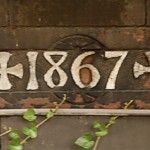A Tale of Two Architects: Upjohn & Cram in Carroll Gardens
Friday, October 8th, 2010Billed as “the largest architectural event in the United States,” Open House New York Weekend is this Saturday and Sunday, October 9th and 10th. Landmark buildings of historic architectural importance all over the five boroughs of New York City will be open to the public for viewing each day. Among Brooklyn’s architectural wonders participating in the Open House event will be St. Paul’s Episcopal Church in Carroll Gardens, situated on the corner of Clinton and Carroll Streets.
Originally designed by Richard M. Upjohn (1828-1903), St. Paul’s was built in the Gothic Revival style popular during the 19th century. (R.M. Upjohn and his father also designed Brooklyn’s Greenwood Cemetery Gate, just a few miles away in Sunset Park). After a fire damaged the church, Ralph Adams Cram (1863-1942) was commissioned to redesign the interior in 1907, and this is where the story gets interesting: Cram is noteworthy among early 20th century architects for his resistance to the overwhelming current of early modernism. He’s been referred to by at least one writer as the “high priest of American Neo-Gothic,” in deference to his passion for pre-renaissance, medieval, Gothic architecture.
An agnostic in his youth, Cram underwent a dramatic spiritual conversion during a Christmas Mass in Rome and subsequently became a fervent Anglican—in fact, the Episcopal Church has honored Cram, along with Upjohn and John LaFarge, with a special Feast Day on the liturgical calendar, December 16. St. Paul’s, an Anglo-Catholic Episcopal church, is the only place where the work of these two important architects, Upjohn and Cram, is layered together within a single structure. Along with his writings on Religion, Art and Architecture, Cram is also the author of a book of ghost stories, Black Spirits and White.
“Gothic is less a method of construction,” Cram once suggested, “than it is a mental attitude, the visualizing of a spiritual impulse.” In the early twentieth century, this kind of attitude went against the grain of the growing, dominant trends of Modernism with it’s trenchant iconoclasm and absolute disdain for anything that valued a sense of continuity with the past. Cram’s sense of history and place, his embrace of mystical philosophies and eloquent theological musings on the nature of art were simply out of place in the cultural milieu that eventually gave us Frank Lloyd Wright’s Guggenheim Museum or the austere, curtain-walled designs of Mies van der Rohe’s glass box buildings.
The following information comes from St. Paul’s Press Release for the 8th annual Open House New York Weekend:
“On Saturday, October 9th from 11 am to 5 pm, there will be ongoing guided tours and self-guided tours in conjunction with “openhousenewyork.” On Sunday, October 10th, there will be an Organ Recital by St. Paul’s Music Director, Andrew von Gutfeld at 1:30 followed by guided tours and self-guided tours from 2-5 pm. Naturally, the parish welcomes everyone to Sunday’s 11 am mass.
“St. Paul’s has a rich history that dates back to Brooklyn’s pre-Civil War era, having been founded in 1849 by Irish Protestants, an often overlooked but important early New York emigrant group. In 1866, the parish asked R.M. Upjohn to design its church, which celebrates the Gothic Revival architectural style that was so popular in mid-nineteen-century America.
“In the decades following 1874, the year St. Paul’s Church was consecrated, the parish faced an identity crisis, with many of its original families having moved away, uncomfortable with Brooklyn’s increasingly non-protestant feel. However, the parish ultimately adopted Anglo-Catholicism, a popular reform movement that combined medieval ritual and community service.
“During this time, the parish commissioned prominent architect Ralph Adams Cram to redesign St. Paul’s interior, after a fire damaged the church in 1907. Cram, who designed the nave at St. John the Divine in Manhattan, gave St. Paul’s interior the Neo-Gothic flavor that it retains today.
“It is important to note that St. Paul’s enjoyed a racially diverse congregation since the 1920s, as it attracted members of Brooklyn’s West Indian community, who worked mostly as servants for wealthy families in Brooklyn Heights. Irving King, a current parishioner of West Indian descent, said his mother liked St. Paul’s because it was the first church where she was not “told where to sit.” This was at a time when segregation in many churches was the norm, when even the taking of communion itself was a segregated act—but not at St. Paul’s.
“Like Brooklyn itself, the church has always changed with the times and reinvented itself, welcoming newcomers in the last twenty years who have gravitated toward an increasingly gentrified Carroll Gardens and Cobble Hill. St. Paul’s today attracts a wide range of people from a range of different ethnic and socio-economic backgrounds, drawing in many young families new to the neighborhood. ”
Click on an image to enlarge:















